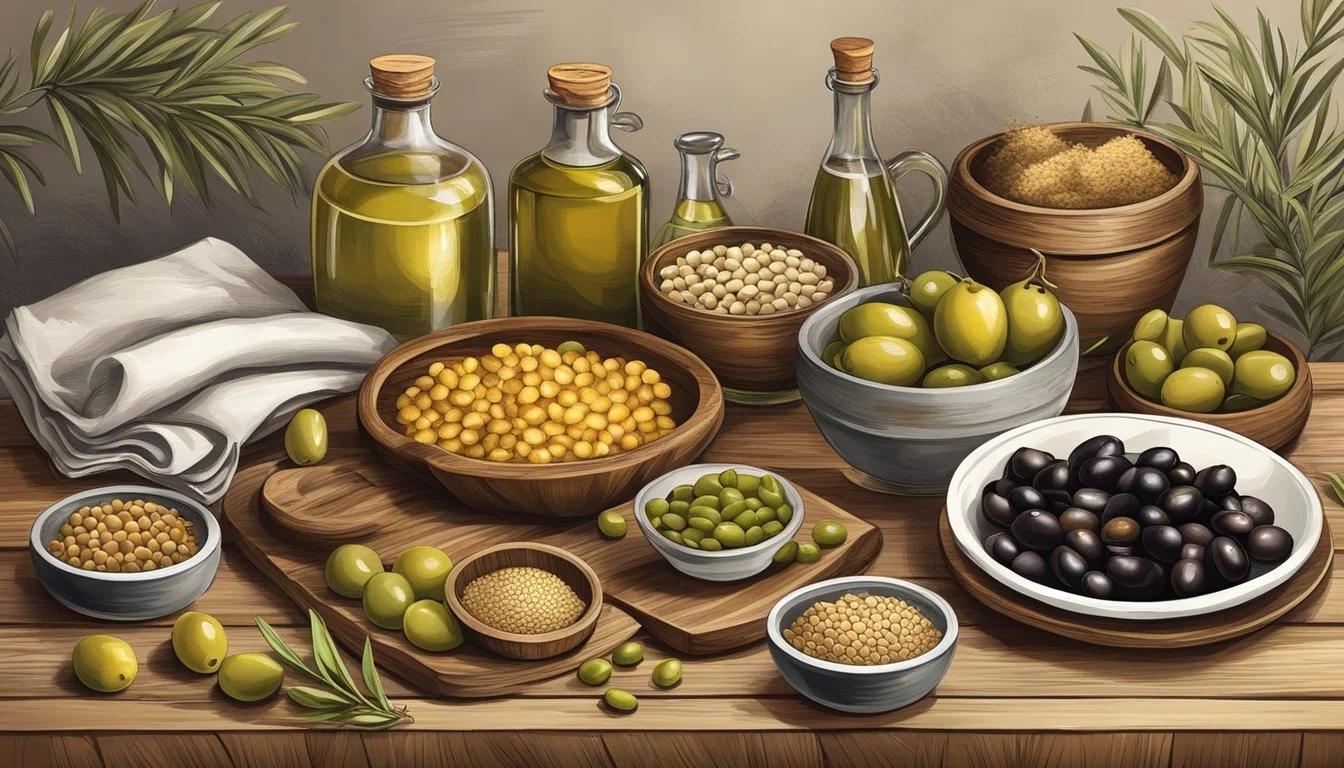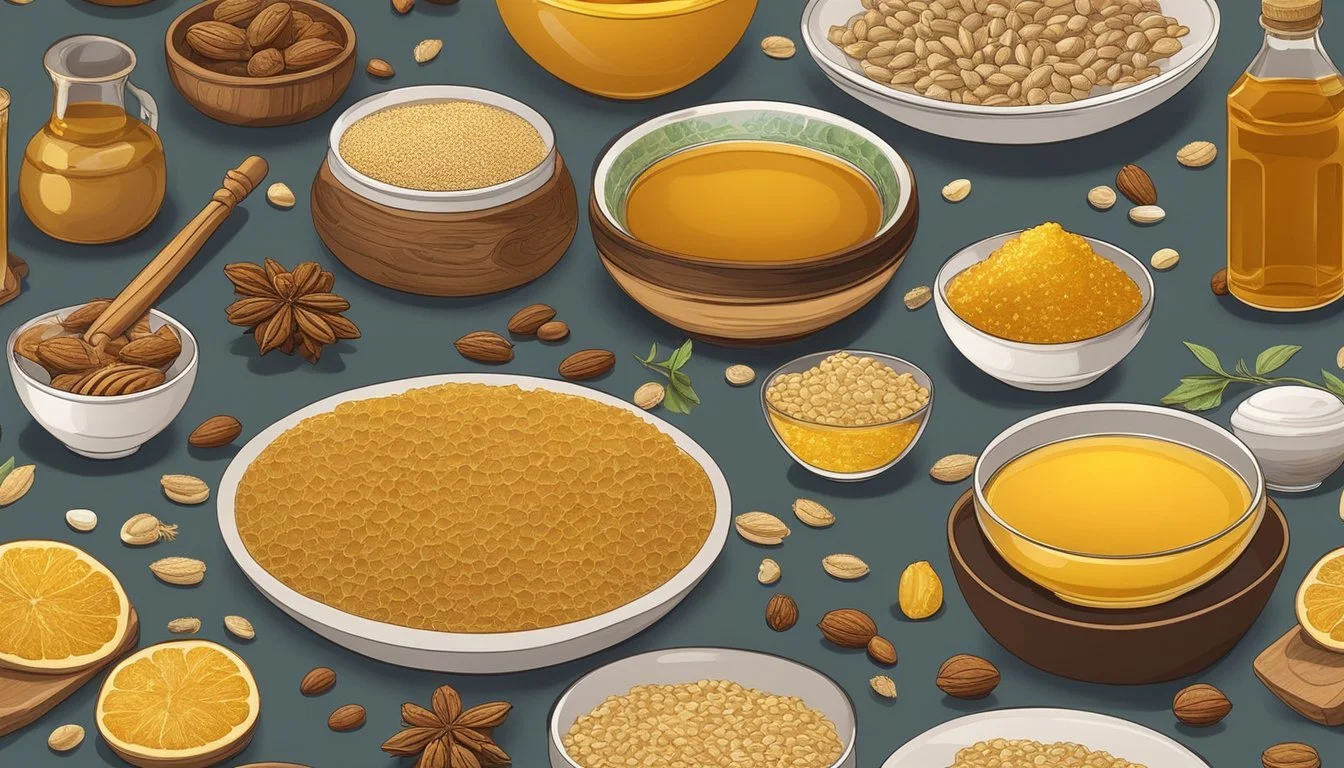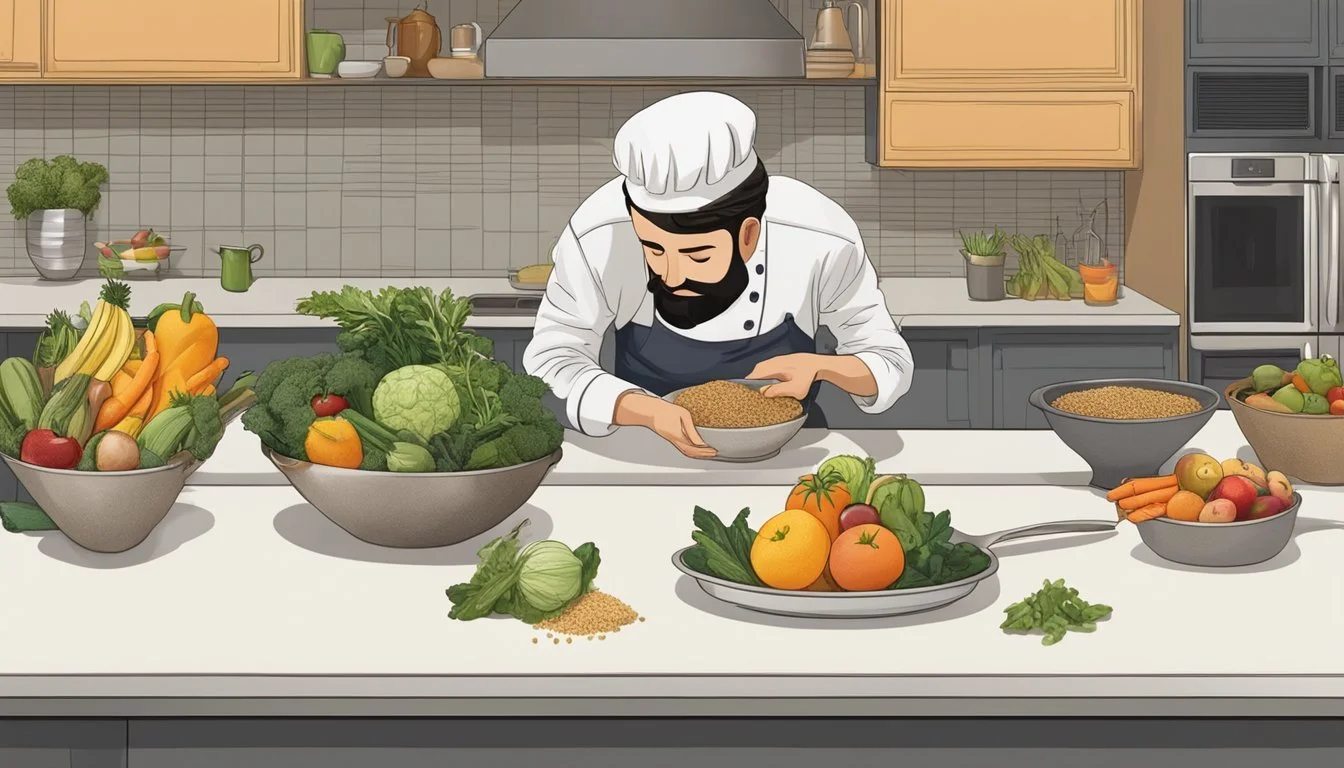10 Ancient Foods People Still Eat
Timeless Culinary Traditions
The culinary practices of ancient civilizations continue to influence modern diets, revealing a fascinating connection between past and present. Exploring the foods from these eras provides insight into the dietary habits, health beliefs, and cultural significance placed upon these ingredients and dishes.
Many ancient foods have endured the test of time, some remaining staples in contemporary kitchens, while others are appreciated for their historical and cultural value. This enduring popularity underscores the timeless appeal and nutritious qualities of these age-old recipes.
1) Olive Oil
Olive oil, often referred to as "liquid gold," has a rich history dating back around 8,000 years. It was first cultivated on the Carmel coast of ancient Israel. This oil has played a significant role in the Mediterranean diet.
Ancient civilizations, including the Greeks and Egyptians, heavily relied on olive oil. They used it not only in cooking but also for medicinal purposes and religious rituals. Olive presses found at ancient sites highlight its long-standing significance.
The production of olive oil involved precise cultivation practices. Olive trees thrive in well-drained, rocky soil, typical of the Mediterranean climate with hot, dry summers and mild winters. Farmers would prune the trees to maximize yield.
One of the earliest evidence of olive oil use dates back to around 5000 BCE. Trade records indicate that it was exported widely, including to Greece and Egypt. This trade helped spread its popularity across the ancient world.
The process of making olive oil has remained relatively consistent over millennia. Simple presses used in ancient times have evolved into more advanced machinery, but the essence of production remains the same. Olive oil continues to be a staple in modern kitchens worldwide.
2) Honey
Honey has been a treasured food for thousands of years, prized for its sweetness and preservative qualities. Ancient civilizations, including the Egyptians and the Greeks, revered honey not just for its taste but also for its medicinal properties.
One of honey's remarkable features is its eternal shelf life. Honey found in ancient Egyptian tombs, still edible after millennia, attests to this. Its longevity partly stems from its high acidity, with a pH between 3 and 4.5, which inhibits the growth of bacteria and fungi.
Historical records show that honey was used as a valuable trade commodity. In addition to being consumed, it served as a component in religious ceremonies and as an antiseptic in wound care.
Today, honey continues to be enjoyed worldwide. Modern scientific analyses have confirmed its numerous health benefits. It's used in various culinary dishes, beverages, and as a natural sweetener. It showcases an enduring legacy as both a nutritious and versatile food.
3) Sourdough Bread
Sourdough bread traces its origins back thousands of years, making it one of the oldest forms of leavened bread. Historians believe that the production of sourdough began around 6,000 years ago, with ancient societies using natural fermentation processes to bake bread.
Ancient Egyptians were among the first to bake sourdough, discovering that wild yeasts, combined with bacteria in the environment, could leaven bread naturally. This technique spread across various cultures, including those in Europe and the Near East.
In medieval Europe, sourdough was a staple, especially in regions where rye was predominant. Rye bread made with sourdough starter helped increase the dough’s acidity, which prevented starches from degrading. This made the bread more durable and flavorsome.
In more recent history, sourdough gained prominence in the United States during the Gold Rush era. San Francisco, in particular, became known for its unique sourdough, thanks to the specific strains of wild yeast and bacteria in the region. Today, San Francisco Sourdough is renowned worldwide.
The basic ingredients of a sourdough starter—flour and water—harbor a community of wild yeasts and bacteria. Over time, these microorganisms ferment the dough, imparting a distinct tangy flavor and chewy texture. This fermentation process not only enhances taste but also makes the bread easier to digest.
4) Garum
Garum is a fermented fish sauce that originated in ancient Mediterranean civilizations. It was a staple in the cuisines of places like Phoenicia, Greece, Rome, and Carthage.
This pungent condiment was made by fermenting fish intestines, along with salt, in large vats. The mixture was left to ferment for several months under the sun.
Garum was highly favored for its strong, savory flavor, enhancing the taste of various dishes. It was often used in place of salt to give meals a rich, umami profile.
High demand for garum led to its export across the Roman Empire. Amphorae filled with the sauce have been found in archaeological sites from Pompeii to remote Roman outposts.
Modern culinary enthusiasts sometimes experiment with garum-inspired sauces, using similar fermentation techniques. While these contemporary versions might include different ingredients, the essence of the ancient recipe remains.
Garum's historical significance underscores its influence on culinary practices, even thousands of years later. It provides a fascinating link between past and present gastronomic traditions.
5) Miso
Miso, a fermented soybean paste, originated in ancient Japan. It has been a staple in Japanese cuisine for centuries.
The earliest known mention of miso dates back to the Heian period (794 - 1185) in Japanese history. It played a significant role in Japanese culture, being used both as a food and as a form of currency.
Miso was likely introduced to Japan from China or the Korean Peninsula. Over time, it became uniquely integrated into Japanese food culture, particularly as a base for soups.
Miso's popularity extends beyond traditional Japanese dishes. It has found a place in Western cooking, fusion cuisine, and modern health-conscious diets.
Miso soup, a common dish in Japan, typically includes ingredients like tofu, seaweed, and scallions. It’s traditionally sipped directly from the bowl without a spoon.
Rich in protein, vitamins, and minerals, miso is also praised for its health benefits, including aiding digestion due to its probiotic content.
In contemporary cuisine, chefs experiment with miso in various dishes, ranging from salad dressings to marinades.
The enduring presence of miso in kitchens around the world attests to its versatility and cultural significance.
6) Lentils
Lentils have been a staple in human diets since ancient times. Archaeological evidence points to their cultivation as far back as 8,000 B.C. on the banks of the Euphrates River. This legume was essential in the Middle Eastern diet, providing a critical source of protein more commonly found in animal products today.
In Ancient Egypt, lentils appeared in both common and royal diets. They were versatile, showing up in various dishes and symbolizing prosperity in several cultures. In India, lentils were a dietary mainstay, especially among followers of Buddhism and Jainism, who followed vegetarian principles.
Egyptian cuisine features lentils prominently, such as in Kushari, the national dish. This street food, with ingredients like rice, macaroni, and lentils, reflects a mix of Indian, Italian, and Middle Eastern influences. It's served with spiced tomato sauce and garlic vinegar, showcasing the legume's adaptability and importance.
Lentils are also significant in Italian and Irish culinary traditions. In Italy, lentils are often eaten during the New Year to symbolize luck and prosperity. Similarly, lentils continue to be a vital component of various regional diets worldwide, proving their enduring relevance and nutritional value.
7) Yogurt
Yogurt has been part of the human diet for several millennia. Its origins trace back to around 6000 BC in ancient India, where it was mentioned in Ayurvedic texts. The word "yogurt" comes from the Turkish word "yoğurmak," meaning to thicken or curdle.
Fermented foods like yogurt were practical in ancient times for preserving milk. Evidence suggests that Neolithic people used pottery to store milk, and the fermentation process created yogurt, which slowed the growth of harmful bacteria due to its natural acidity.
In Ancient Greece, yogurt was well-known and commonly consumed. Despite its modern association with Greek cuisine, historical consumption of yogurt was widespread across various cultures.
Yogurt's health benefits have long been recognized. It provides probiotics, which promote gut health, and its nutrient content, including calcium and protein, makes it a valuable part of the diet. Over time, its preparation methods have evolved, but the core concept remains the same.
8) Kefir
Kefir is a fermented milk drink with ancient roots in the North Caucasus Mountains, located in modern-day Russia and Georgia. This drink is made by adding kefir grains, which are a combination of bacteria and yeasts, to milk, kickstarting the fermentation process.
Historically, kefir was discovered by shepherds who noticed that their milk would ferment into a tangy, effervescent beverage when stored in goat stomach leather bags. Over time, this drink has been valued for its unique taste and potential health benefits.
Kefir contains probiotics, which are beneficial for gut health. These live microorganisms can help balance the digestive system. Some studies suggest that kefir may reduce tumor growth and help in managing cholesterol and blood pressure levels.
In the 20th century, kefir's popularity surged in Russia. It was first commercially produced in 1908 by The Blandovs using grains procured by researcher Elie Metchnikoff. By 1930, it became widely available across the country and remains a staple in many diets today.
Kefir can be consumed on its own as a drink or added to recipes such as smoothies, salad dressings, and soups. Its versatility and health benefits make it a lasting favorite in various cultures around the world.
9) Sausages
Sausages have a rich history, tracing back thousands of years. The ancient Romans enjoyed a variety of sausages, including Lucanica, a sausage made from pork and pine nuts. This tradition of sausage-making was a staple at Roman banquets.
Emperor Constantine I, who ruled in the fourth century A.D., reportedly banned certain pagan festivals that included sausage consumption. Despite this, sausage-making persisted and evolved through the ages.
The Egyptians, for example, have been making a type of sausage called Mombar Mahshy for approximately 5,000 years. This ancient delicacy involves stuffing cow intestines with beef, lamb, rice, and spices.
Sausages remain popular in many cultures today. These ancient practices have influenced modern sausage production, blending traditional techniques with new flavors. Sausages are enjoyed globally, from Italian salami to German bratwurst, demonstrating their enduring appeal and versatility in cuisine.
Roman and Egyptian contributions to sausage-making underscore their significant culinary legacy. The processes of stuffing and fermenting meats have stood the test of time, showcasing the ingenuity and timelessness of ancient food traditions. Sausages continue to be a beloved food in contemporary diets around the world.
10) Naan
Naan is a type of flatbread originating from Central Asia. It has been a staple food for centuries, particularly among nomadic tribes. These early versions were simple, cooked on open flames or hot stones.
Made from basic ingredients like wheat flour, water, and yeast, naan provides a soft and chewy texture. The dough is traditionally cooked in a tandoor oven.
In Indian cuisine, naan is often served with curries and grilled meats. It can be flavored with various toppings such as garlic, herbs, or cheese, enhancing its versatility and appeal.
Naan's enduring popularity extends beyond Asia. It is enjoyed worldwide in diverse culinary cultures.
Historical Significance of Ancient Foods
Ancient foods hold a rich historical significance that spans cultural importance and nutritional benefits. They offer insights into the societies that cultivated and consumed them while also highlighting time-tested health advantages.
Cultural Importance
Ancient foods are deeply rooted in the rituals, traditions, and social structures of their originating cultures. The Etruscan invention of Testaroli, an early form of pasta, underscores the culinary innovation of ancient Italy. Similarly, the Linzer Torte from Austria illustrates how desserts have been integral to European celebrations since the 1600s.
Foods like whole wheat bread, beans, and barley were not merely sustenance; they were part of spiritual and societal ceremonies. Olive oil, used by Mediterranean civilizations, played a role in trade and religious offerings. These foods provide a tangible link to our shared past and highlight the interconnectedness of food, culture, and history.
Nutritional Benefits
Many ancient foods have stood the test of time because of their significant nutritional benefits. Cereals, beans, and vegetables were daily staples, providing essential vitamins and minerals. Maize, a cornerstone of Mesoamerican diets, offered carbohydrates and fiber, supporting the agricultural lifestyle.
Even less common foods like dormice were valued for their protein. The dietary practices of ancient societies were often well-balanced and based on the local ecosystem, ensuring that the nutritional needs of the population were met. These ancient diets can offer modern insights into sustainable and healthy eating practices, emphasizing the value of locally sourced and unprocessed foods.
Techniques and Methods Used to Prepare Ancient Foods
Ancient foods were prepared using a variety of techniques that have either evolved or remained much the same. These methods ensured food preservation, safety, and enhanced flavor.
Traditional Cooking Methods
Ancient civilizations utilized basic yet effective techniques for cooking and preservation. Drying was among the earliest methods, removing moisture to prevent spoilage. This method was used for meats, fruits, and grains.
Another common practice was fermentation, which preserved and enhanced the flavor of foods like vegetables and dairy. The process relies on natural bacteria to break down sugars, producing lactic acid. Equally noteworthy is salting, where salt is used to draw out moisture and create an inhospitable environment for bacteria.
Smoking added flavor while drying foods and was particularly useful for preserving fish and meats. Burying in cool, consistent environments, such as peat bogs or underground pits, kept foods like butter and vegetables from spoiling.
Modern Adaptations
Modern technology has adapted these ancient techniques for current culinary practices. Refrigeration and freezing have largely replaced traditional drying and smoking but are based on the same principles of moisture control and bacterial inhibition.
Fermentation remains popular, seen in foods like yogurt, sauerkraut, and kimchi, with improved safety and consistency through better control of bacterial cultures. The practice of making jams and jellies, using heated sugar and fruit pectin, can be traced back to ancient methods of preserving fruit with honey.
Canning, developed in the 1790s, is a newer addition but considers the timeless techniques of heat treatment to kill bacteria, followed by sealing to keep out new contaminants. Modern adaptations ensure food remains safe, nutritious, and flavorful.
The Role of Ancient Foods in Modern Cuisine
Ancient foods carry not only historical significance but also present a unique fusion in today's culinary world. From reinventing traditional recipes to emerging as gourmet trends, these foods continue to influence modern tastes and techniques.
Fusion Dishes
Modern chefs frequently blend ancient ingredients into contemporary recipes, creating fusion dishes that offer the best of both eras. For example, testaroli, an ancient Etruscan pasta, finds new life in dishes that marry traditional Italian flavors with modern sauces and herbs.
Innovative takes on ancient foods often make them more accessible and appealing to today's diners. Cheesecake, which dates back to ancient Greece, now appears in various forms, including vegan and gluten-free versions, making it suitable for diverse diets.
Restaurants and home cooks alike bring old-world staples like barley and millet into trendy new settings. These grains, once central to ancient diets, now star in salads, grain bowls, and even desserts. This seamless integration of ancient and modern culinary practices helps to preserve heritage while appealing to contemporary palates.
Gourmet Trends
Ancient foods frequently appear in the realm of gourmet cuisine, where their historical roots add an element of allure and sophistication. Traditional preparations of dishes such as Linzer torte, originating in Austria, are often kept close to their original form, celebrated for their rich flavors and cultural heritage.
Gourmet chefs often highlight these foods on menus, emphasizing their unique origins and historical significance. Ingredients like artisanal whole wheat bread or heirloom beans are prized for their connection to unaltered agricultural practices, appealing to today’s health-conscious gourmet diners.
In addition, ancient foods are being explored in the context of sustainability and ethical eating. The re-emergence of ancient grains and traditional cooking practices fits well with modern desires for clean eating and ecological responsibility, making them a staple in high-end restaurants.
Ancient foods not only bridge a gap between past and present but also broaden the culinary imagination, offering rich narratives and diverse flavors that continue to resonate today.







